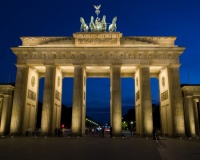Brandenburg Gate (1788)
The 18th century triumphal arch in Berlin
The Brandenburg Gate is one of the most renowned landmarks in Germany, symbolizing the past events in Germany and Europe. Commissioned by the King of Prussia, Frederick William II, the gate was built to signal peace soon after the Thirty Years’ war. The Brandenburg gate has lived through historical turmoil and various regimes, from that of the Third Reich to the “evil empire” of the USSR as claimed by Ronald Reagan during the Cold War. With the fall of the Berlin wall, the Brandenburg gate reopened and continues to be visited by natives and tourists alike. The key events that have occurred in German and European history make the Brandenburg gate an important place for the international community to come and show their appreciation for this emotional past. Initially built as a sign of peace, the gate represents a relationship between different nations and cultures, which has been built on over the years as various happenings have taken place. Ultimately the Brandenburg gate has provided the setting for exchanges and experiences between divergent nations, regimes, cultures and peoples and thus remains a distinctive monument in Berlin.
